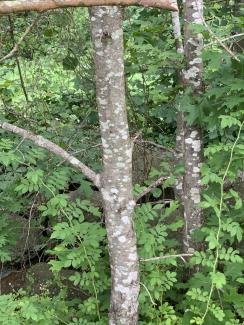
Habitat: Dry to, occasionally, mesic upland forests and woodlands; most characteristic of dry, acidic, nutrient-poor soils. Common in the mountains (although absent from the higher elevations) and piedmont; frequent in the coastal Plain.
Wildlife value: Supports a wide variety of Lepidopteran (butterflies and moths). The tree is an important source of food for many wildlife species. For an oak, it grows fast and bears acorns in 20 years. Acorns are eaten by woodpeckers, blue jays, small mammals, wild turkey, white-tailed deer, and black bear and are can be eaten by people after tannins are leached or boiled out. Plant NOVA Natives lists this species as particularly popular with the non-native honeybees
Notes: Long-lived, durable, and easy to grow.
Earth Sangha Inventory
Founded in 1997, the Earth Sangha is a nonprofit public charity based in the Washington, DC, region. The Wild Plant Nursery is the most comprehensive source of local-ecotype, native plants in the Washington DC region, and the region’s only facility dedicated exclusively to this type of propagation. “Local-ecotype” plants are propagated from local, wild, naturally-occurring populations and are well-adapted to local conditions and for wildlife species that depend on the local forms, such as pollinators. Inventory is updated on a weekly basis so number may not be accurate.
| Pots Available | Plugs Available | Location | Notes | ||
|---|---|---|---|---|---|
| 0 | 0 | Row 12 | View My Wishlist |



